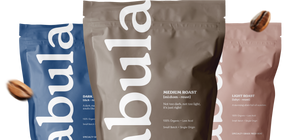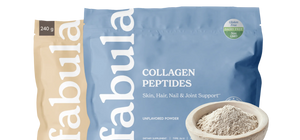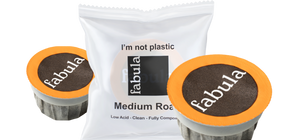Coffee Guide Part 1: Brewing Basics
Coffee Brewing Guide: Brewing Basics

Coffee is a brewed drink prepared
from roasted coffee beans,
the seeds of berries from certain
Coffee species.
Coffee Basics:
Table of contents
Click to go

Hello fellow Fabulian!
Let's start brewing some amazing coffee! Coffee is a marvelous, unique drink, which can be prepared in so many different ways, tailored to each of our individual taste buds. There are thousands of possibilities, but the right way is the way you like it! It all comes down to the way we extract aroma and flavor from our beans
This guide is the first of two parts. Here we walk you through the basics of coffee, and in the second part we dive into different brew methods
We hope you will experiment and have fun with it
Beans and Roast profile

Even the best master brewer cannot make great coffee with mediocre beans! The good news is, that this is where coffee gets really exciting. Flavor will depend on country/origin, region, altitude, shadegrown (or not), the variety of the bean (arabica, robusta, blends, etc.) and, importantly, roast technique. At Fabula, we only work with single origin beans. It makes the profile totally unique. Flavors and aromas will change, even from the same farm. There are different seasons, different harvests, different barometric pressures and so on. It is something dynamic and organic. Just like wines will taste different in different vintages, coffee will also vary. Many consumers will not notice these subtle differences, but they are there, and we think that is part ofthe magic of coffee.
Freshness of the roast is absolutely essential. Coffee peaks 1-3 weeks after roasting. Like fine wine, the beans need to breathe and mature. In scientific terms, the beans will let the CO2 from the roast wear off, which takes a bit of time. Too high CO2 levels will make the flavor extraction erratic and uneven. We should mention that all Fabula bags come with degassing valves, which allow this process to happen. 1-3 weeks after roast, your coffee will be at its very best. From week 3, quality starts to decline, and flavors and aromas will be less and less intense. Especially the higher, more acidic notes will disappear, otherwise making for a balanced cup. After 2 months, the coffee will have gone stale, most flavor notes and delicacies will be gone, and we do not recommend coffee older than this. Ideally, you buy coffee every 2-3 weeks, in just the right quantity according to your consumption. Find a brand that roasts, bags and ships throughout the week (ehem, we are right here, ok?), and you will bein great shape.
Beans and Roast types

Let’s talk about roast types. A popular misconception is that dark roasts are stronger and more intense. That is actually not the case. Roast affects the flavor profile, but coffee strength depends more on factors like grind, water/coffee ratio and brew technique. Lighter roasts tend to be higher in acidity, with intense aromas and more clearly defined flavor notes. They are lower on body and bitterness. Darker roasts are inverse: lower in acidity and aroma, but with more body, more roundedness and some would tend towards bitterness. Medium roasts are the happy compromise: There will still be much of the flavor variety, delicacy and notes of a light roast, but the intensity is somewhat reduced, making for a less acidic and more smooth coffee, and a perfect compromise for many. Caffeine tends to disappear the darker the roast is, so a light roast will give you most of your caffeine kick. Dark roasts will make you less jittery. Most coffee aficionados drink light or medium roasts. We encourage you to try out different options, and find what you like best. In the end, the coffee you like best, is the right one for you.

Light Roasted
BITTERNESS
ACIDITY
AROMA
BODY
Medium Roasted
BITTERNESS
ACIDITY
AROMA
BODY
Dark Roasted
BITTERNESS
ACIDITY
AROMA
BODY
Grind Size
Some people prefer to buy their Fabula coffee already ground. It’s less messy and quicker. However, when buying whole beans it opens up more options for tailoring your cup. When beans are ground, the oxidation process is faster, meaning aroma and flavors are lost quicker. We recommend grinding your beans immediately before brewing. Not only will your coffee be better, we think it’s a great ritual, a time to send a thought to all the people who helped the coffee on its way, and a moment to enjoy!
Different brew techniques require different grind sizes. An espresso, which pushes pressured steam through the beans, will require a very fine grind. Contact time between water and ground beans is only 20-30 seconds, so the beans need to work their magic fast. At the other end of the spectrum, we have cold brew, which leaves the beans to “simmer” for around 12 hours, and needs a very coarse grind. Drip or pour over will need a medium grind.

Espresso
20 - 30 Seconds
Fine Grind

Cold Brew
12 Hours
Coarse Grind
Grindes Types

Espresso
Fine Grind

Aeropress
Fine - Medium
Fine Grind

Drip Machine
Medium Grind

Pour Over
Medium Fine
to Medium Coarse

Chemex
Medium Coarse

French Press
Coarse

Cold Brew
Extra Coarse
It’s physics, really: a finer grind will have more surface of the coffee bean, and a quicker extraction. A coarser grind will allow water to pass through the coffee with less resistance, and hence needing more time to pick up the flavors.
You can see here which grind size is appropriate for your coffee brew method.
Grinders can be inexpensive (around $10), or quite pricey ($2,000 and above). They typically come in two types: Blade grinders, which basically chops and cuts the coffee beans, much like a propeller. They are effective and inexpensive, but they also make a somewhat neven grind. For many people, blade grinders are perfectly fine, especially in the early stages of a coffee love affair. The other type is burr grinders, aka burr mills, made up of two revolving burrs. The beans are crushed between a moving grinder wheel and a non-moving surface. That makes for a more uniform grind, and a more even coffee extraction.

blade grinder

burr grinder
Water-to-Coffee Ratio
A good rule of thumb is 1.5 to 2 levelled tablespoons of ground coffee for every cup (240ml) of water. You may want to check the cup lines on your coffee device to see how they measure up. But be careful, as “cups” can vary widely on different machines. To be more accurate, the guideline is 6-8g coffee per 100ml water. Once again, individual taste preferences are at play. Brew technique/device also has an impact, as some lose more water to evaporation. Under each brew method, which we will go through in Fabula’s Guide Part II, we will indicate a specific water-to-coffee ratio. Do some iterations within the guideline ratio, and find the sweet spot for you. There might be more than one sweet spot for you, depending on bean and roast profile!
That was the basics! Mix it up and have fun with it! Remember, a dark roast that you love in your espresso, might also work really well in a more coarse grind (i.e. ending up with a different profile) for your drip coffee. Or, you may prefer something entirely different, bean or roast, for each brew type. The combinations - and reasons to love coffee - are literally endless.

Water and Temperature

tap water is not ideal
to get the best out of
your coffee beans

the water needs to be as neutral
as possible, and not over-saturated
with minerals, especially calcium
Just like you need good tomatoes for a good pasta sauce, you also need good water for coffee. You need the water to be as neutral as possible, and not over-saturated with minerals, especially calcium. Calcium mutes flavors in the coffee. Calcium levels vary greatly depending on where we live. You can check your water source according to SCAA’s water standards. Or, just buy purified water in your local supermarket. Most people will use tap water, which can be ok, but trust us when we say water quality matters if you want the best out of your precious beans.
Brewing water temperature should be somewhere between 195 and 205 degrees Fahrenheit. Water boils at 212 degrees Fahrenheit, so this is just below boiling. In practice, that means boiling your water and leaving it about 2 minutes to cool off. Too hot water will over-cook the coffee. Too cold water will leave your coffee beans under-extracted, and make it bitter and acidic.








